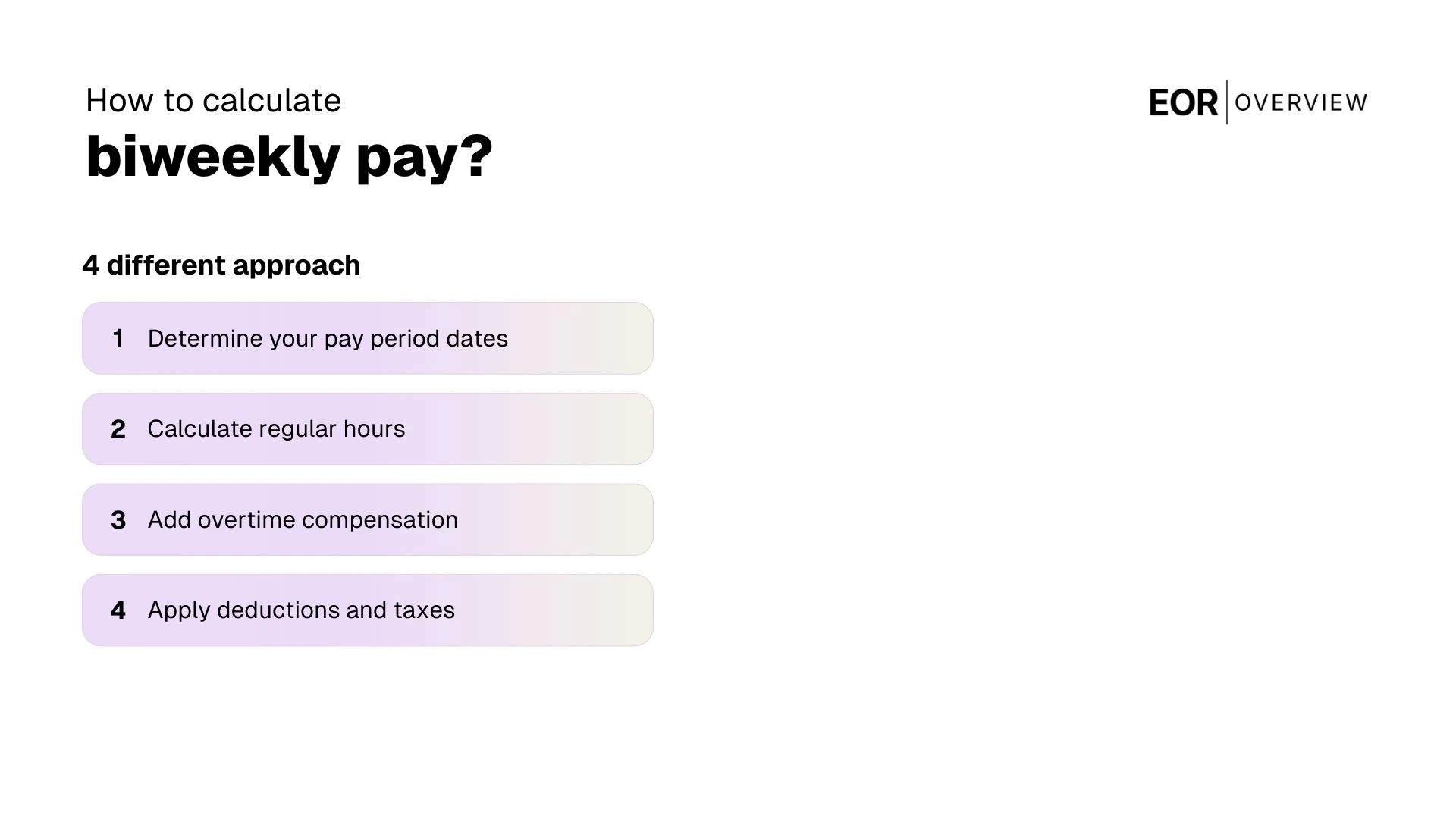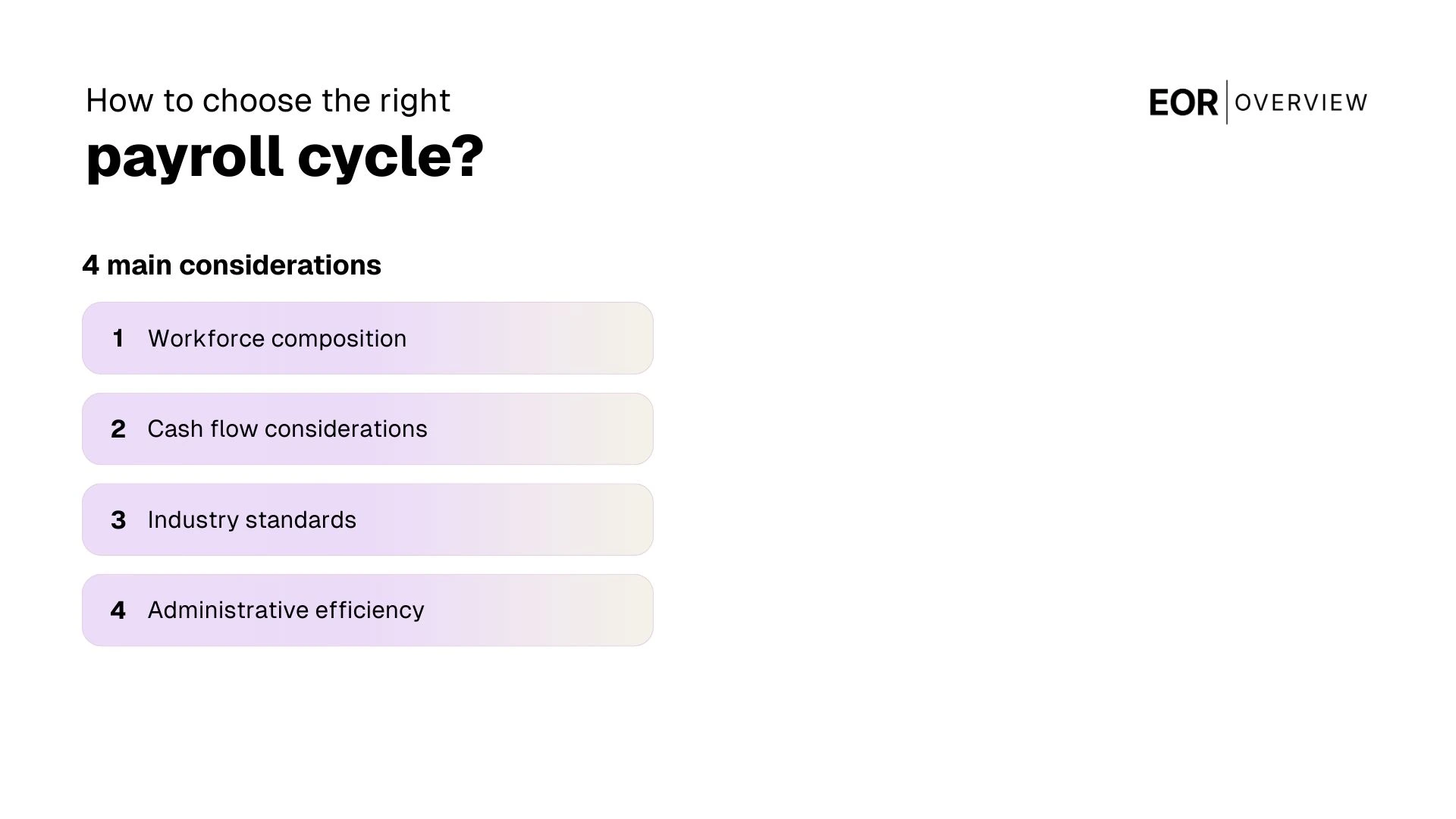Bi-weekly payroll is a payment schedule that delivers employee compensation every two weeks, typically resulting in 26 pay periods per year and providing a balanced approach between cash flow management and employee expectations.
For HR managers in tech, finance, and startup environments, bi-weekly payroll offers the sweet spot between administrative efficiency and talent retention. This payment frequency aligns with modern workforce expectations while maintaining predictable payroll processing cycles that support both budgeting accuracy and employee financial planning.
Most growing companies find that bi-weekly payroll reduces administrative overhead compared to weekly payments while offering more frequent compensation than monthly schedules, making it particularly attractive for organizations scaling their workforce rapidly.
What is bi-weekly payroll?
A biweekly pay schedule is a payroll system where employees receive their paychecks every two weeks, resulting in 26 pay periods throughout the year. This approach means that most months will have two pay dates, while two months annually will include three paychecks due to the mathematical reality of 52 weeks divided by 26 pay periods.
Under a biweekly pay period structure, the pay cycle typically runs from Sunday to Saturday or Monday to Sunday, depending on your organization's preference. Each biweekly payroll covers 80 hours of work for full-time employees, making calculations straightforward for both hourly and salaried staff members.
This pay schedule has become increasingly popular among tech companies, financial institutions, and startups because it balances administrative efficiency with employee satisfaction. The biweekly system aligns well with project cycles and provides predictable cash flow patterns that support both operational planning and employee budgeting needs.
How does biweekly pay work?
Biweekly pay operates on a 26-pay-period schedule where each employee receives their paycheck every two weeks on the same day. This creates a consistent payday rhythm that employees can rely on, with most organizations choosing either Friday or the last working day of the pay period for distribution.
The system differs significantly from semi-monthly pay, which delivers only 24 paychecks per year on specific calendar dates. With biweekly payroll, your team receives 26 paychecks annually, meaning two months will have three paydays instead of the usual two.
For hourly employees, each paycheck covers exactly 14 consecutive days of work, making overtime pay calculations straightforward since the weekly overtime threshold applies within each two-week period. Salaried employees receive their standard amount divided by 26 pay periods, creating smaller paychecks compared to semi-monthly schedules but more frequent income distribution.
What industries use biweekly pay?
Biweekly payroll systems are widely adopted across multiple industries, with companies paying employees every other week to create predictable payment schedules. This approach results in 26 pay periods per year, making it easier for HR teams to calculate consistent payroll cycles regardless of the specific day of the week chosen for payment.
Technology sector: Tech companies favor biweekly pay because it aligns with sprint cycles and provides employees with regular income flow while simplifying payroll processing for rapidly scaling teams.
Financial services: Banks and financial institutions use biweekly systems to maintain consistent cash flow management and meet regulatory compliance requirements for employee compensation.
Healthcare industry: Hospitals and medical facilities rely on biweekly payroll to manage complex shift schedules and ensure accurate overtime calculations for their diverse workforce.
Manufacturing: Production companies implement biweekly pay to coordinate with production cycles and provide stable income for hourly workers across multiple shifts.
When transitioning to biweekly payroll, choose a consistent day of the week for payments and communicate the change at least 30 days in advance. This helps employees adjust their budgeting while giving HR sufficient time to update payroll systems and ensure compliance with state wage payment laws.
Bi-weekly payroll vs. semi-monthly payroll
Understanding the difference between bi-weekly and semi-monthly payroll helps employers choose the right pay frequency for their organization. Both systems affect how you calculate biweekly payments, manage cash flow, and structure employee compensation across different roles.
Bi-weekly payroll: Processes payments every two-week period, resulting in 26 pay periods in a year. This system works well for hourly pay calculations since it aligns with standard work schedules.
Semi-monthly payroll: Distributes payments twice per month on fixed dates, creating 24 pay periods annually. This approach simplifies salary calculations for salaried employees and provides consistent monthly pay scheduling.
The key consideration involves cash flow management and employee preferences. Bi-weekly systems create two months each year with three paychecks, requiring careful budgeting. Semi-monthly systems offer predictable pay dates that align with monthly expenses, making it easier for employees to manage their finances and for employers to forecast payroll costs.
What are the benefits of providing bi-weekly pay?
Bi-weekly payroll offers significant advantages for organizations looking to streamline their compensation processes while maintaining employee satisfaction. This payment schedule provides predictable cash flow management, simplified payroll administration, improved budget forecasting, enhanced employee financial planning, and reduced administrative overhead. These benefits create a win-win scenario for both employers and employees across various industries. These benefits are listed in detail below.
Predictable cash flow management: With 26 pay periods across 52 weeks, finance teams can accurately forecast payroll expenses and maintain consistent cash flow patterns throughout the year.
Simplified payroll administration: Your payroll provider can process payments more efficiently with a standardized bi-weekly schedule, reducing the complexity of calculating different pay periods for various employee groups.
Improved budget forecasting: Finance departments can create more accurate annual budget projections when payroll costs are distributed evenly across 26 predictable payment cycles.
Enhanced employee financial planning: Employees receive consistent paychecks every two weeks, making it easier for them to budget their personal expenses and plan for recurring monthly bills.
Reduced administrative overhead: HR teams spend less time managing payroll queries and corrections since employees become accustomed to the regular payment schedule and can easily calculate biweekly pay based on their hourly rate and hours worked.
What are the challenges of providing bi-weekly pay?
While a bi-weekly payroll schedule offers numerous benefits, it also presents several operational challenges that HR managers must navigate carefully. These challenges span from complex calculations to employee satisfaction concerns.
The main challenges of implementing bi-weekly pay include complex overtime calculations, cash flow management difficulties, employee confusion about pay dates, system integration complications, and increased administrative burden for hourly employees. These challenges are listed in detail below.
Overtime calculation complexity: Companies must carefully track when employees exceed 80 hours across two-week periods, requiring more sophisticated time-tracking systems than weekly payroll schedules.
Cash flow management strain: Organizations need to manage larger payroll amounts less frequently, which can create budgeting challenges and require more substantial cash reserves.
Employee adjustment period: Workers transitioning from weekly or monthly pay schedules often struggle with budgeting when they pay their employees bi-weekly, leading to potential satisfaction issues.
System integration difficulties: Payroll software must accurately multiply hours and rates across two-week periods while handling various deductions and benefits calculations.
Administrative burden increase: HR teams face more complex record-keeping requirements and must ensure accurate time tracking across extended pay periods, particularly for businesses with mixed hourly and salaried staff.

How to calculate biweekly pay?
Calculating bi-weekly payroll requires a systematic approach to ensure employees are paid accurately for the hours worked in a two-week period. Most organizations choose a specific day of the week, typically occur every other Friday, to maintain consistency in their payroll processes.
Determine your pay period dates: Establish the exact start and end dates for each two-week cycle, ensuring employees receive clear communication about when their work period begins and ends.
Calculate regular hours: Multiply the employee's hourly rate by the total regular hours worked during the pay period, typically capped at 80 hours for full-time employees every two weeks.
Add overtime compensation: Include any overtime hours at the appropriate rate (usually 1.5x regular pay) for hours exceeding 40 in either week of the pay period.
Apply deductions and taxes: Subtract federal, state, and local taxes, plus any voluntary deductions like health insurance or retirement contributions.
🎯 Pro Tip: Since bi-weekly payroll results in 26 pay periods per year instead of 24, communicate clearly with employees about the three pay periods that occur twice annually to avoid confusion with budgeting.
This frequent pay schedule helps employees per paycheck by providing more regular income flow compared to monthly payroll, making it particularly popular in tech and finance industries where cash flow predictability supports employee satisfaction.
When to use bi-weekly payroll?
Bi-weekly payroll works exceptionally well for organizations with a mix of hourly and salaried employees. This schedule provides the perfect balance between administrative efficiency and employee satisfaction, making it ideal for tech companies, financial institutions, and growing startups that need predictable payroll operations.
Companies should consider bi-weekly payroll when they want to streamline their wage calculations across different employee types. Since businesses pay their employees biweekly every 14 calendar days, both hourly and salaried employees receive consistent payment timing, which simplifies HR processes and reduces confusion.
The bi-weekly system particularly benefits organizations experiencing rapid growth or seasonal fluctuations. When you pay your employees on this schedule, you'll process exactly 26 pay periods throughout the calendar year, making budget forecasting and cash flow management more predictable for finance teams.
This payroll frequency also aligns well with most banking systems and direct deposit schedules, ensuring smooth transactions. Organizations with remote teams across different time zones find bi-weekly payroll especially valuable since it provides enough processing time to handle any technical issues or compliance requirements without rushing.

How to choose the right payroll cycle?
Selecting the right payroll cycle requires careful consideration of your workforce composition, industry standards, and operational capabilities. Companies that use biweekly pay cycles often find they balance administrative efficiency with employee expectations more effectively than other frequencies.
The main considerations include workforce composition, cash flow management, administrative burden, industry standards, and compliance requirements. These factors are listed in detail below.
Workforce composition: Companies with hourly employees benefit from biweekly cycles since hours worked in a two-week period align naturally with standard work schedules, while salaried employees receive consistent amounts when their annual salary is divided by 26 pay periods.
Cash flow considerations: Biweekly payroll results in 26 pay periods annually, meaning two months per year will have three paycheck cycles, requiring careful budget planning for these periods.
Industry standards: Industries that most commonly use biweekly pay include technology, finance, and manufacturing, where employees receive paychecks every two weeks as the standard practice.
Administrative efficiency: Processing payroll every two weeks reduces administrative burden compared to weekly cycles while still meeting employee preference for regular payments.
Remember that switching payroll cycles requires advance notice to employees and may temporarily disrupt their budgeting. The Department of Labor (DOL) requires proper notification of any changes to pay frequency, and some states have specific regulations governing payroll cycle modifications.

